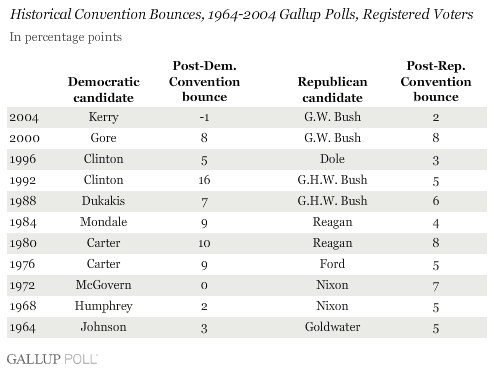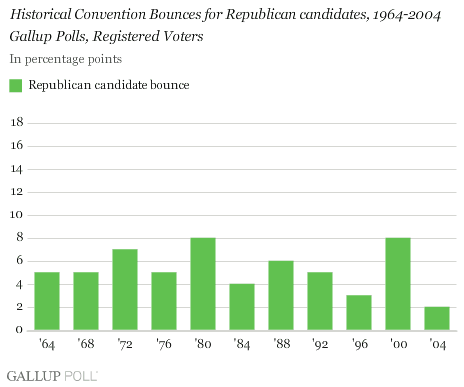PRINCETON, NJ -- To the extent history is a guide, Barack Obama and John McCain can both expect to see some increase in voter support after their nominating conventions, an effect observed after nearly all of the 22 national conventions since 1964. The median increase has been 5 percentage points.
This "convention bounce" is an important part of the presidential campaign narrative, and is one of the more highly anticipated events for poll watchers. Gallup has data to provide a reasonable estimate of each presidential candidate's convention bounce dating back to 1964. All but two candidates -- George McGovern in 1972 and John Kerry in 2004 -- saw their support among registered voters increase after their parties' conventions.

The largest bounce in Gallup's polling history was a 16-point increase for Bill Clinton after the 1992 Democratic Convention, as Clinton and the Democrats successfully tied George H.W. Bush to the country's economic woes. Clinton seized the lead after that convention and never relinquished it on his way to winning the election. (Third-party candidate Ross Perot dropped out of the race coincident with the Democratic Convention, which created a political vacuum Clinton helped fill, but the 16-point bounce is based on a comparison of Bush vs. Clinton trial heats before and after the Democratic Convention.)
Of course, it can be risky to predict the future based on historical patterns. In 2004, neither Kerry (whose support dropped 1 point after his party's convention) nor George W. Bush (whose support increased just 2 points) got a significant boost from their parties' conventions. Both fell well below the historical norm of 5-point increases and now rank as the single worst post-convention showings of any presidential candidate of their respective parties.
It is unclear at this point whether 2004 marks the start of a trend away from post-convention bounces, or is a historical anomaly. One thing that distinguishes 2004 from earlier elections is that voters were already tuned in to the campaign well before the conventions took place and likely already had given some thought to how they would vote. Thus, the happenings of the conventions arguably would have had little effect on their preferences.
In earlier elections, the conventions may have been the first time that many voters began to pay attention to the presidential race, and thus their preferences were more subject to change. So far, 2008 looks more like 2004 than earlier elections in terms of pre-convention voter interest levels, and if the convention bounces of 1964 through 2000 were largely a product of low pre-convention levels of voter attention, then there may not be big surges in candidate support this year.
Factors Affecting the Bounce Size
History shows that a 5-point convention bounce has been typical, no matter the particulars of the convention in terms of political party and incumbency/convention order. (The average or mean bounce of 6 points is slightly higher than the median 5-point bounce, but the mean is unduly influenced by the large 1992 Clinton result; the mean excluding that data point is equivalent to the median of 5 points.)
On average, Democratic candidates have enjoyed slightly larger bounces than Republicans (6.2 points to 5.3), but that difference is entirely due to influence of the 1992 Clinton bounce. If that one example is taken out, then the parties' average bounces are the same (5.2 Democratic, 5.3 Republican).
What does distinguish the parties is the much greater variability in the size of Democratic bounces. Democrats can claim the four largest bounces (Clinton '92, Carter '76 and '80, and Mondale '84) but also three of the four smallest (Humphrey '68, McGovern '72, and Kerry '04), ranging from -1 to +16 points.

Republicans' convention bounces have fallen more narrowly between +2 and +8 points.

The political tradition is that the party currently occupying the White House holds its convention second. Thus, this year, Obama and the Democrats will lead off the back-to-back convention weeks, with McCain and the Republicans following.
Going first or second doesn't seem to confer any advantage or disadvantage in terms of the size of the convention bounce. The average bounce for the first conventions in an election year is 6.3 points (5.3 excluding 1992) and for second conventions is 5.2 points.
Implications
The conventions are one of the most anticipated events of the political calendar, and thus, their potential to shift voter preferences is great. In 1988 and 1992, the conventions were the turning points in the campaign, moving the formerly trailing candidate ahead for the duration. In other years, such as 1980 and 2000, the conventions produced a change in the front-runner, but not a permanent one, as subsequent events (in particular, the debates) led to changes later in the campaign.
Typically, Gallup finds candidates gaining 5 points in the polls after their conventions, though it is far from a guarantee that the candidates will receive bounces of that size in 2008.
There are a number of factors that could lead to smaller-than-usual convention bounces this year, most notably the tightly compressed convention schedule, with the GOP Convention beginning just four days after the Democratic Convention ends. Also, it is rumored that McCain will announce his vice presidential running mate the day after the Democratic Convention ends, stealing away some of the political spotlight from Obama the day after he gives his presidential nomination acceptance speech. Lastly, the high level of early voter attention may also reduce the potential for significant shifts in voter preferences after the conventions.
To provide feedback or suggestions about how to improve Gallup.com, please e-mail feedback@gallup.com.
